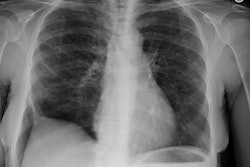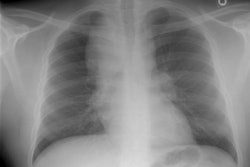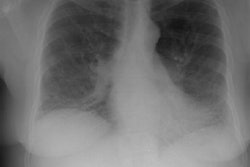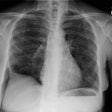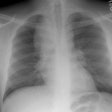AJR Am J Roentgenol 1997 Jan;168(1):79-83
CT findings during phase of accelerated deterioration in patients with idiopathic pulmonary fibrosis.
Akira M, Hamada H, Sakatani M, Kobayashi C, Nishioka M, Yamamoto S
Department of Radiology, National Kinki Chuo Hospital for Chest Disease, Osaka, Japan.
OBJECTIVE: Most patients with idiopathic pulmonary fibrosis (IPF) show slowly progressive deterioration. However, accelerated deterioration also occurs in patient with IPF who have previously shown slowly progressive deterioration. The purpose of this study was to evaluate the CT findings of accelerated deterioration in patients with IPF. MATERIALS AND METHODS: We evaluated the CT findings of 17 patients with IPF who fulfilled all the following criteria for accelerated deterioration of IPF: exacerbation of dyspnea within 1 month, new diffuse pulmonary opacities on chest radiography, a decrease in arterial oxygen tension (PaO2) of more than 10 mm Hg under similar conditions, and absence of apparent infectious agents and heart failure. Seven patients underwent sequential CT examination. Pathologic specimens were obtained from nine patients. RESULTS: CT findings were classified as peripheral parenchymal opacification (n = 6), multifocal parenchymal opacification (n = 6), and diffuse parenchymal opacification (n = 5). Multifocal lesions developed diffusely in two of the seven patients who underwent sequential CT. These two patients both died. Three of the six patients with a multifocal pattern responded to corticosteroid therapy. All patients with a peripheral pattern showed various degrees of improvement following corticosteroid therapy. Multifocal and diffuse parenchymal opacification corresponded pathologically to acute diffuse alveolar damage. Peripheral parenchymal opacification corresponded pathologically to active fibroblastic foci. CONCLUSION: CT patterns seen during periods of rapid deterioration in patients with IPF may allow predictions of prognosis and of response to treatment.
PMID: 8976924, MUID: 97131272
